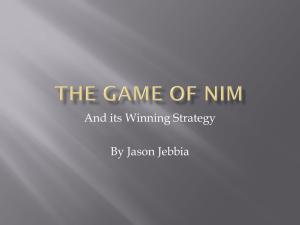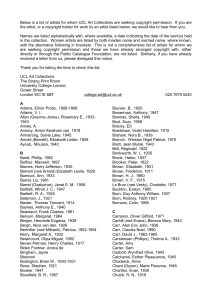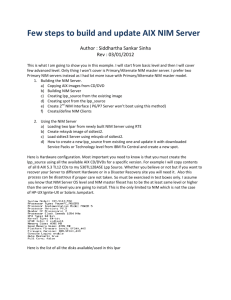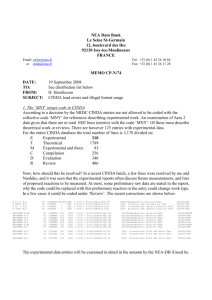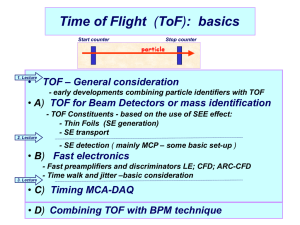About_Me_files/Ernst Thesis Article2
advertisement
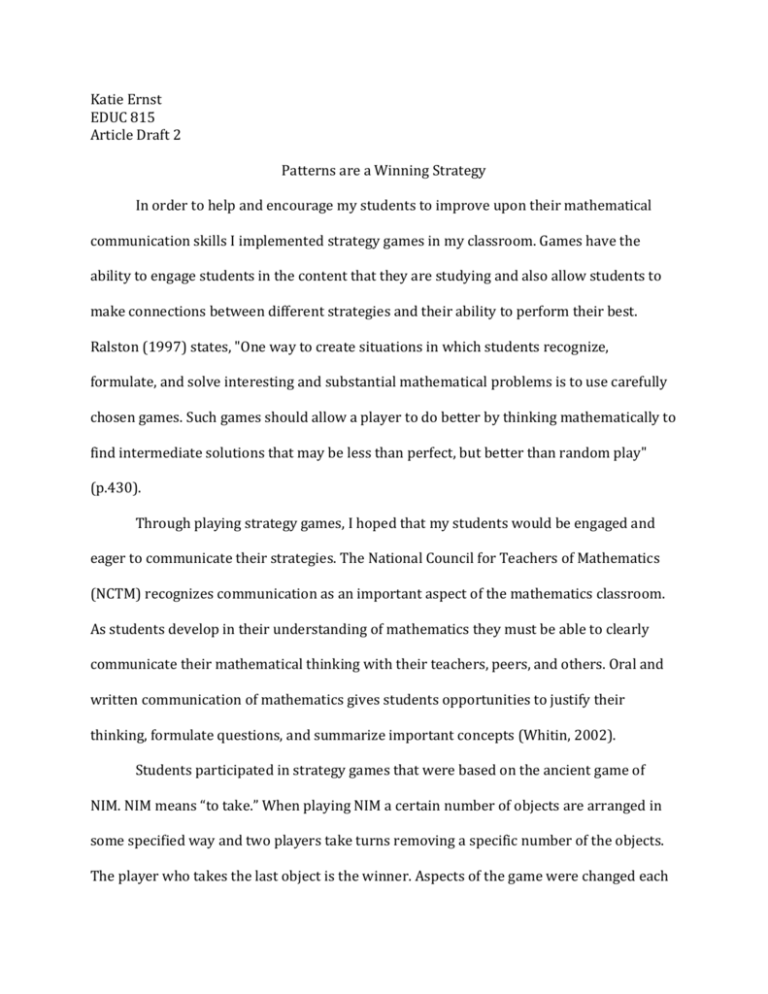
Katie Ernst EDUC 815 Article Draft 2 Patterns are a Winning Strategy In order to help and encourage my students to improve upon their mathematical communication skills I implemented strategy games in my classroom. Games have the ability to engage students in the content that they are studying and also allow students to make connections between different strategies and their ability to perform their best. Ralston (1997) states, "One way to create situations in which students recognize, formulate, and solve interesting and substantial mathematical problems is to use carefully chosen games. Such games should allow a player to do better by thinking mathematically to find intermediate solutions that may be less than perfect, but better than random play" (p.430). Through playing strategy games, I hoped that my students would be engaged and eager to communicate their strategies. The National Council for Teachers of Mathematics (NCTM) recognizes communication as an important aspect of the mathematics classroom. As students develop in their understanding of mathematics they must be able to clearly communicate their mathematical thinking with their teachers, peers, and others. Oral and written communication of mathematics gives students opportunities to justify their thinking, formulate questions, and summarize important concepts (Whitin, 2002). Students participated in strategy games that were based on the ancient game of NIM. NIM means “to take.” When playing NIM a certain number of objects are arranged in some specified way and two players take turns removing a specific number of the objects. The player who takes the last object is the winner. Aspects of the game were changed each time to see how students were able to evolve their strategies to win. While students played the games they filled in a worksheet to document the strategies that they were developing. The first NIM game that the students played was Stuff NIM. To play this version of NIM, groups of 2 students each lined up 14 objects in a single row and took turns taking one or two of the objects. The student who took the last object was the winner. Many students looked for patterns in the number of objects taken away or worked backwards to develop a winning strategy. As students worked together, the most popular strategy that developed was to give your partner a "count by three number" of pieces and then when your opponent takes two you take one and vice versa. A few days later the students learned how to play Calculator NIM. I wanted to see if students were able to make connections between this game and Stuff NIM. In calculator NIM the students choose a target number and enter it into the calculator. Then they take turns subtracting one, two, or three. The player who subtracts the last number to make the display read zero is the winner. After playing the game many times and discussing their strategies with their classmates the students decided that the best strategy was to give their opponent “count by four numbers” and then follow the pattern that if your opponent takes away one then you take away three, if your opponent takes away two then you take away two, and if your opponent takes away three then you take away one. The students recognized that this was a similar strategy to the winning strategy in Stuff NIM. The students were then introduced to Pattern Block NIM. In this game the students played on a game board that was made up of connected hexagon pattern blocks. The students then took turns placing a trapezoid, rhombus, or triangle pattern block on the board. The blocks had to be placed so that at least one side lined up with one side of the board. The winner is the one who places the last block. The students recognized that this game was similar to calculator NIM. They said that the triangles represented one, the rhombi represented two, and the trapezoids represented three. This recognition allowed students to use the number strategies that they already developed to try to find a winning strategy for this game. The next NIM game that the students played was Add Up NIM. To play this game the students had to choose a target number between 20 and 35. The students then took turns starting at zero and adding one, two, three, or four to their total. The person who reached the target number won. During this game one student made a realization that you want to give your partner "count by five numbers." This will help you win because "it is one more than the highest number that you can take." When playing Stuff NIM the highest number of pieces you could take was two; therefore you wanted to give your opponent "count by three numbers." In Calculator NIM and Pattern Block NIM the highest number of pieces you could take was three, therefore you wanted to give your opponent "count by four numbers." This was evidence that the students were relating the different NIM games. The students were then introduced to Integer NIM. In this game the objects are placed in two rows of five. The students take turns taking away one or two objects in either row or one from both rows. The player who takes the last piece wins. This game followed the student's previous realization. The greatest number of pieces that you can take away in this game is two. According to the student you want to give your opponent "count by three numbers." Another student stated on this day that if you give your opponent "count by three numbers" you are giving them a "multabal" (multiple) of three. The students that recognized this pattern could start at any number of pieces and recognize who should go first and how many pieces to take away. During the sessions the students were able to recognize patterns in the games and apply them to the problem to develop the best strategy. Once students recognized that there might be a pattern in the winning strategies, it made it easier for the students to develop new strategies. They would modify a strategy from one game and apply it to another. This was determined through one of the student's ideas that you want to give your opponent multiples of the number that is "one more than the greatest number you can take away." There was also evidence of this when the students were able to view pattern blocks as numbers in Pattern Block NIM. This allowed students to use number strategies that were already developed to determine a winning strategy for this game. Students also learned that they could benefit from other students' strategies. Evidence of this was seen in the games of Stuff NIM and Calculator NIM when students used their own strategy in combination with another student's strategy to develop a winning strategy. Strategy games are an effective way to help students apply patterns to problem situations. Students determined that patterns are a useful method for solving a problem. This is an important realization because it will help students in their understanding of algebra. Throughout playing the NIM games students were actively involved in sharing their thoughts and strategies with their peers. Students gained confidence in their ability to communicate. They also recognized that the more specific they were in their explanations, the easier it was for their peers to understand. Students realized that vocabulary was very important. They began to use the word "opponent" to identify who was playing because it became confusing when they used the terms you and I. Students also recognized that when identifying the winning position they needed to state whether you should give that position to your opponent or if you wanted to play from that position. The strategy games were engaging and provided a means for communication. The students were not afraid to share their ideas because they were confident that they had made their strategy work and that it could be used in conjunction with another student's strategy. Students wanted recognition for finding the winning strategy. In order to achieve this they had to be able to explain their strategy effectively. Throughout this research the students also became more confident in their ability to write about mathematics. In the beginning they did not want to write down their strategies because it was "too difficult." However, once the students had a chance to communicate their thoughts orally they were able to write them down. By orally communicating their strategies students were able to formulate the words that they needed to clearly express themselves. The students found that it was beneficial to write their thoughts down because it made it easier to go back to modify their strategy. Strategy games are an effective way for students to build their confidence and ability to write about mathematics. This is an important skill because students need to know how to explain their answers. Students wanted to write down their strategies so that they would be able to use them again when playing the game. Students recognized the importance of clearly listing each step of the strategy, so they would understand it when they looked at it again. If their writing was unclear then they may not remember the winning strategy. Implementing strategy games into my classroom was an effective strategy to help students make connections among mathematical concepts and to communicate their mathematical understandings. References National Council of Teachers of Mathematics. (2000). Principles and Standards for School Mathematics. Reston, VA: NCTM. Pfeiffer, S. (1998). Creating nim games: math projects series. United States: Dale Seymour. Ralston, A., Willoughby, S. (1997). Realistic problem formation and problem solving [Electronic version]. The Mathematics Teacher, 90, 430-435. Whitin, D., Whitin, P. (2002). Promoting communication in the mathematics classroom [Electronic version]. Teaching Children Mathematics, 9, 205-210. This article is developed from my Master’s Thesis. In revising this second draft, David was able to read through my first draft and give me suggestions. This was very helpful, because I have worked with this data extensively and left out aspects that were not obvious to a person who was reading this for the first time.
